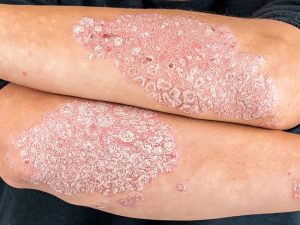by JANEL ZITZKA
As a dermatology nurse and laser technician, I help people every day to achieve healthy, clear skin. Many patients’ skin care concerns are directly related to sun damage. The complicated, delicate balance of healthy skin and how easy it is to upset never ceases to amaze me. Hormones, bacteria, intrinsic and extrinsic factors are but a few of the many different factors that can lead to cutaneous maladies.
One common inflammatory disease process we see on a daily basis at Associated Dermatology is rosacea. Rosacea is a chronic yet treatable condition that involves inflammation primarily over the central face. It is often mistaken for other skin conditions with similar presentation such as sun damage or acne vulgaris. As such, proper diagnosis is integral in managing and treating rosacea.
Rosacea in addition to persistent redness over the central face that can flare may sometimes be accompanied by a burning or stinging sensation. Oftentimes we see flares present as papules or pustules, what patients often think of as acne. Over time, the redness traditionally gets ruddier and small telangectasias (small vessels) can develop. In other instances, rosacea may present as thickened tissue around the nose, called rhinophyma. Some patients have involvement of the eyes, presenting with watery, bloodshot or irritated eyes. This is referred to as ocular rosacea.
Many patients with rosacea are burdened with the physical look of their condition, leading to a high correlation with low confidence and low self-esteem. Some patients avoid social situations such as sports, dinner with friends and professional interactions. Spicy foods, sun exposure and emotional stress can also trigger rosacea.
While rosacea is not curable, it can be managed and the goal of clear skin or almost clear skin is what we strive for when treating patients with rosacea. Sometimes a low-dose antibiotic can be taken orally to help achieve more clear skin. The advantage to treating with low-dose antibiotics, such as doxycycline, is that we are utilizing the anti-inflammatory properties without risking the development of antibiotic resistance. Another medication used to manage rosacea is a topical agent, such as metronidazole. These are just a few “tools in our toolbox” to consider when we are forming treatment plans for patients.
Though conventional methods can achieve good results, one of the drawbacks is the hassle of daily application or ingestion. Oral and topical medications help to reduce the presentation of redness and papules, but they fail to actually debulk the burden vascular network rosacea tends to create. Dermatologists have used light-and-energy-based devices for years to reduce the size and amount of fine telangectasias and background erythema (redness). Traditionally Nd:YAG 1064nm vascular lasers are used to treat the larger vessels one can see with the naked eye. Broadband light technology addresses the classic background redness of rosacea and when used in conjunction with vascular laser results can be very long lasting while potentially taking the place of traditional daily medication.
Rosacea is a persistent, multi-factor condition and as such requires proper diagnosis and customized treatment. Your dermatology-trained provider should work with you and the ongoing management of rosacea as it can become increasingly severe. In dermatology, we are always striving to find new and innovative ways to help rosacea patients, so I encourage you to check in with your dermatologist as recommended to see what progress is being made the field of dermatology and study of rosacea.







